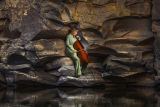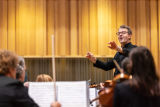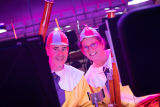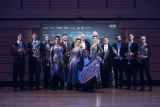Opera You Didn’t Know You Knew
By TJ Wilkshire
Blog ·

A beginner’s guide to the world of opera and the thrilling orchestral music accompanying these spine-tingling arias.
Just like our Classical Music You Didn’t Know You Knew blog post, we give you our round up of opera we’re certain you’ve heard before. Your ears are sure to perk up at these familiar tunes!
#‘Largo al factotum’ from 'The Barber of Seville'
Gioachino Rossini
Two hundred years after Rossini’s The Barber of Seville was written, it is still considered a masterpiece. The opera first premiered in Rome in 1816 and later took Vienna by storm. In the beloved aria Largo al factotum, the repeated ‘Figaro, Figaro, Figaro’ is iconic (and that’s the part we think you’ll recognise), but the piece is renowned as one of the most difficult to perform.
This aria is the ultimate example of the kind of work Rossini is famous for – the music starts softly, building louder and louder, whilst the action on stage escalates to a feverish and chaotic pace. Rossini demands skill, control and flair from the soloist as they navigate all of this. An absolute masterpiece to listen to, there’s so much going on in Largo al factotum that it’s worth sitting down and taking a moment to really appreciate all the moving parts.
#‘Queen of the Night’ (Der Hölle Rache) from 'The Magic Flute'
Wolfgang Amadeus Mozart
Mozart’s opera The Magic Flute is a mixture of Shakespearean comedy and magic. The iconic and fast-paced 'Queen of the Night' aria performed by a soprano depicts a fit of vengeful rage wherein the Queen of the Night tells her daughter, Pamina, to murder the Queen’s rival or else she will disown and curse Pamina forever. It’s a highly dramatic moment if anything else. To a new listener this aria can only be described as menacingly chirpy – the frenetic pace of the music matches the stratospheric notes sung by the soprano, both increasing the tension of the moment. It’s the kind of music that sends shivers down your spine. You can’t help but be impressed by any orchestra that can match and keep up with the soloist.
# ‘La donna è mobile’ from 'Rigoletto'
Giuseppe Verdi
The aria also known as ‘Woman is Fickle’ from Verdi’s opera Rigoletto is considered one of the greatest moments in operatic canon and is an opportunity for tenors to really show off their range. From pizza and Superbowl ads to game scores and films, this aria has been used for all occasions in popular culture.
The recognisable theme (a dramatic waltz-like build of strings and brass) of ‘La donna è mobile’ is introduced immediately and repeated several times throughout the aria. The popular melodies of this piece make it catchy and accessible for opera fans and newbies alike. Trust us, we know you’ll be humming this one in your sleep.
#‘Habañera’ from 'Carmen'
Georges Bizet
Carmen’s first production in Paris in 1875 shocked audiences with its unashamedly realistic depiction of the main character Carmen. With her overt sexuality and her rowdy female chorus Carmen herself has become a symbol of the femme fatale and other strong female characters. The music heard in this aria is most strongly identified with Carmen’s character throughout the opera – it’s gutsy and just like the character, incredibly unforgiving. Bizet’s variations in the refrain and his diverse use of instruments throughout make this aria a memorable one. We think the main tune is so iconic you’re likely to know it without even realising it.
#‘Nessun Dorma’ from 'Turandot'
Giacomo Puccini
What better way to finish our round up than with an aria that tickles the fancy of opera fans, music lovers and football fanatics too. Performed in the final act of Puccini’s opera Turandot, ‘Nessun Dorma’ became both Pavarotti’s signature aria and the unofficial anthem for the 1990 FIFA World Cup held in Italy. The opera itself is melodramatic – the story tells of beheadings, unrequited love and mass killing all for the love of a princess. Moving and poignant, the music behind this aria alone is worth listening to – the mournful strings at the beginning turn into a crescendo that is absolutely spine-tingling. You cannot help but yearn for the majestic melodies of the chorus, and marvel as the tenor soars on the high notes. It’s magnificent.



